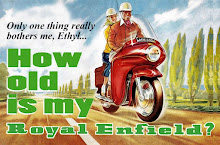 |
| This Royal Enfield Super Meteor set the pace in 1957. |
This is the sound of a 700cc Royal Enfield Super Meteor at speed.
The Royal Enfield immediately jumps to an 80-yard lead over pursuing Triumph, Norton, BSA and Velocette competitors.
It's the National Nine-Hour Race of June 29, 1957.
Royal Enfield's performance that day was best summed up by reporter Roger Maughfling, in The Motorcycle News, Wednesday, July 31, 1957.
His article was entitled "Nine Hour Super Meteor."
Bear that in mind: the racers at Thruxton that day ran for nine hours, at speeds that could exceed 100 mph. To win they would have to complete more than 200 laps of the airfield.
The runway portions of the course -- naturally the fast straightaways -- were by 1957 rough and weedy from lack of maintenance since the war.
 |
| The Motorcycle News applauded the "Nine Hour Super Meteor." (Royal Enfield Owners Club Archive) |
"One of the outstanding features of the recent Clubman's Nine-Hour race at Thruxton was the performance of the Royal Enfield Super Meteor entered by Lawton and Wilson, of Southampton, and ridden by Derek Powell and Brian Newman. Had it not been for a leaking fuel tank the Royal Enfield would most likely have scored an easy outright win.
"As it was, despite some twenty minutes lost effecting temporary repairs (not entirely successful) and the subsequent need to stop for refueling at frequent intervals because not more than a gallon could be carried before leakage from the crack in the top of the tank became pronounced, the Meteor finished second in its class and third in the race as a whole."
Maughfling subsequently got the chance to try that very Super Meteor racer for himself. A stock Super Meteor was capable of close to 100 mph. He found the racer capable of more than 115 mph, despite clubman rules requiring full road equipment, including working lights.
"I was told that the increased speed was due largely to the use of 9:1 compression ratio pistons (available from the factory) to cleaning out the ports and to ultra-careful assembly. Because of the race regulations even the carburetor was the stock instrument with a bore of only one inch," Maughfling wrote.
This was race winning speed, and, luckily, you can watch the race highlights in a 20-minute Castrol Motor Oil film from the period. (Scroll down to the end of this blog item to watch the race on YouTube.)
The period film captures the courage and heartbreaking effort the leather-clad racers of the day put in. One rider pushed his motorcycle a mile in hope that a repair in the pits could put him back in the race.
It was a long and hot day. And then it started to rain.
Of the 43 starters, only 21 finished. The Royal Enfield Super Meteor was one of them.
Here's some of the play-by-play from the film:
"Powell's big Royal Enfield is going like a bomb. It's almost certainly the fastest machine out today.
 |
| Super Meteor in the lead. |
"It's a quarter-to-one and Derek Powell is still leading handsomely on his 19th lap. He's averaging well over 70...
 |
| Momentary distraction for cameraman. |
"After an hour and 20 minutes Powell has a break and Newman presses on with the Royal Enfield."
 |
| Change of riders for Super Meteor. |
 |
| Another fuel tank fitted, but it leaks too. |
"It's past 8:30 and the sun sinking low. Powell and Newman, Royal Enfield are third...
 |
| Hanging on for third place. |
 |
| Super Meteor is flagged in third. |





























No comments:
Post a Comment